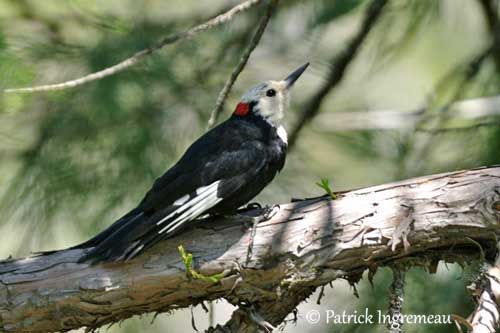
Fr: Pic à tête blanche
All: Weißkopfspecht
Esp: Pico Cabeciblanco
Ital: Picchio testabianca
Nd: Witkopspecht
Sd: Vithuvad hackspett
Photographers:
Tom Grey
Tom Grey's Bird Pictures
Patrick Ingremeau
TAMANDUA
Text by Nicole Bouglouan
Sources:
HANDBOOK OF THE BIRDS OF THE WORLD Vol. 7 by Josep del Hoyo-Andrew Elliott-Jordi Sargatal – Lynx Edicions – ISBN: 8487334377
FIELD GUIDE TO THE BIRDS OF NORTH AMERICA - National Geographic Society - ISBN: 0792274512
BirdLife International (BirdLife International)
Bird Web (Seattle Audubon Society)
What Bird-The ultimate Bird Guide (Mitchell Waite)
White-headed Woodpecker
Picoides albolarvatus
Piciforme Order – Picidae Family
BIOMETRICS:
Length: 24 cm
Wingspan: 43 cm
Weight: 52-68 g
DESCRIPTION:
The White-headed Woodpecker differs from most of woodpeckers by its black and white body and white head.
The adult male has black body plumage overall, except on head and wings which show white bases to most of primaries, extending sometimes almost to tip on outer webs. Two or three white spots are visible near tip of outer web on central primaries. The wing-coverts and the breast show weak blue gloss.
On the head, forehead, crown, lores, head sides and chin to upperbreast are white. We can see some buff tinge on forehead, and greyish wash on crown. A narrow, fine blackish line is visible behind the eye. The nape is red.
The fairly long bill is blackish-grey and chisel-tipped. The eyes are deep brown-red. Legs and feet are grey.

The female has similar plumage but with black nape.
The juvenile is browner than adults. The white wing patch may be larger but barred dark, and the belly may also have some paler bars. The young male has orange-red nuchal patch. The young female has small one restricted to the hindcrown.
The subspecies P.a. gravirostris has longer tail and bill than nominate. The larger bill is an adaptation for feeding on the large, spiny cones of Coulter Pines.
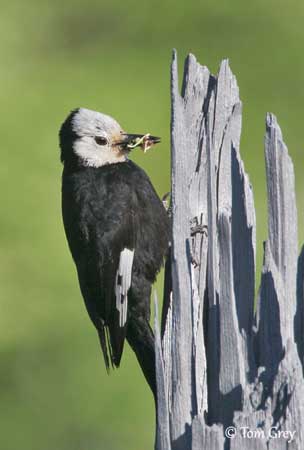
VOICE: SOUNDS BY XENO-CANTO
The White-headed Woodpecker’s call is a “peek-it” or “pee-dink”, and often with three notes “pee-dee-dink”.
We can also hear a phrase varying in length “kit-kit-kit-kit-kit”.
Male and female drum and perform rhythmic tapping at nesting cavity.
HABITAT:
The White-headed Woodpecker frequents the relatively open Pines ponderosa forests at fairly high elevation, from 850 to 2750 metres in Sierra Nevada.
It favours the tall, open coniferous forests in mountains, even with mixed tree species.
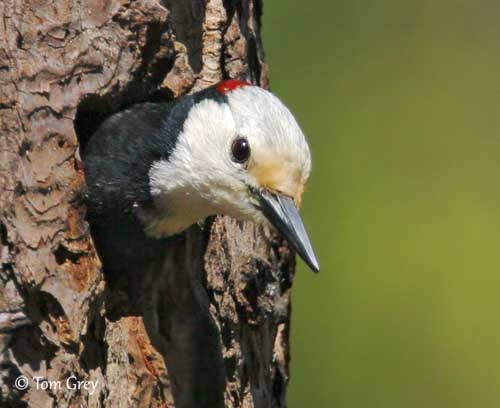
RANGE:
The White-headed Woodpecker of race “gravirostris” is found in SW California, in mountains around Los Angeles and San Diego.
The nominate race occurs from SC British Columbia, S in mountains to Washington state, W Idaho, Oregon, California and extreme W Nevada.
BEHAVIOUR:
The White-headed Woodpecker feeds primarily on insects and their larvae such as ants, beetles and homoptera. But it also takes plant items such as the pine seeds extracted from the cones, and also pine sap. It may frequent the feeders where it consumes suet.
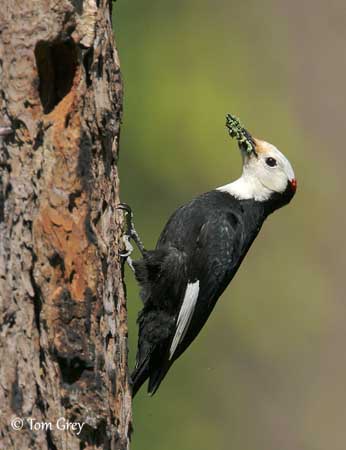
This species is usually seen alone or in pairs. They forage in large conifers, mainly at low level on trunk, on large branches and in the pine needle clusters.
It extracts the seed from the cones by clinging to them. It also comes down to the ground.
In the southern parts of the range, male and female have different foraging areas, with female feeding more on trunks and male on cones.
They remove the bark and then, they probe and peck to find insects and larvae. They may perch upside down and sideways to reach the food.
They may occasionally catch flying insects by sallies.
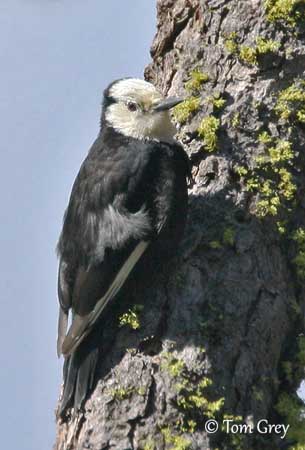
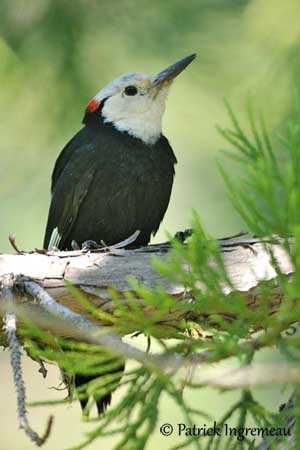
Drumming is used as advertising sound, accompanied by vocal signals.
Some aggressive encounters may occur at the beginning of the breeding season, taking place around the nest-sites and at food sources.
The male performs flutter-aerial displays during courtship. This display includes a gliding flight with the wings held above the back, while the bird utters series of drawn-out squeaky calls.
This species is mainly resident in its range, with some altitudinal movements and post-breeding dispersion.
FLIGHT:
The White-headed Woodpecker has undulating flight as most of Picidae species.
REPRODUCTION:
The breeding season occurs between May and July, from April in southern regions.
Both mates excavate the nest-hole in snag, stump of sloping log, or live tree, and mainly in conifers. They excavate during 3-4 weeks, between 2 and 4 metres above the ground. The depth is about 20-25 cm, with a diameter entrance of 4-6 cm.
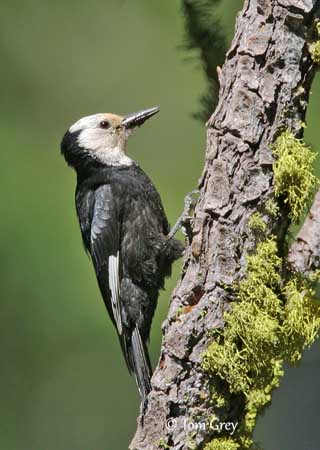
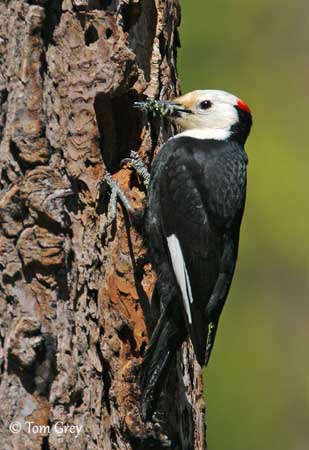
The female lays only one brood of 4-5 eggs. The incubation lasts two weeks, by both parents.
The chicks are brooded and fed by the adults which also clean the hole. The young fledge 26 days after hatching. They depend on parents for several weeks after fledging, and are divided between the two adults.
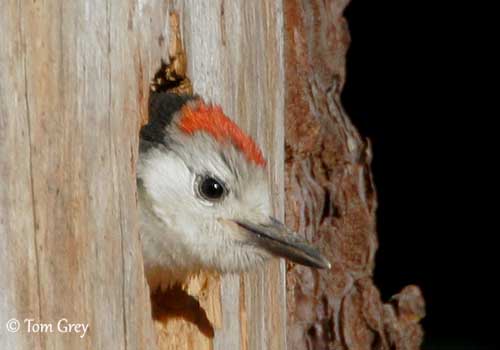
DIET:
The White-headed Woodpecker feeds mainly on insects and larvae found after removing the bark on tree trunk. It also takes seeds from cones and pine sap.
PROTECTION / THREATS / STATUS:
The White-headed Woodpecker is uncommon to rare in the northern parts of the range, but fairly common or common in other regions.
This species can be tolerant of forest disturbance, if there are suitable stumps and logs for nesting.
The populations are stable, but the main threat is the loss of large trees, and degradation and fragmentation of the habitat.
However, this species is not currently threatened.